Order my debut cookbook, Pakistan: Recipes and Stories from Home Kitchens, Restaurants and Roadside Stands. Featuring 100+ delicious recipes, stunning photography and essays that ground the food in place and context, "Pakistan" is the most complete look at Pakistani cuisine to date!
A spicy, smoky and peppery chana dal that is the embodiment of Pakistani roadside food. It’s similar to the dhaba mash ki dal that many of us grew up having. It’s best enjoyed with a side of thick naan.
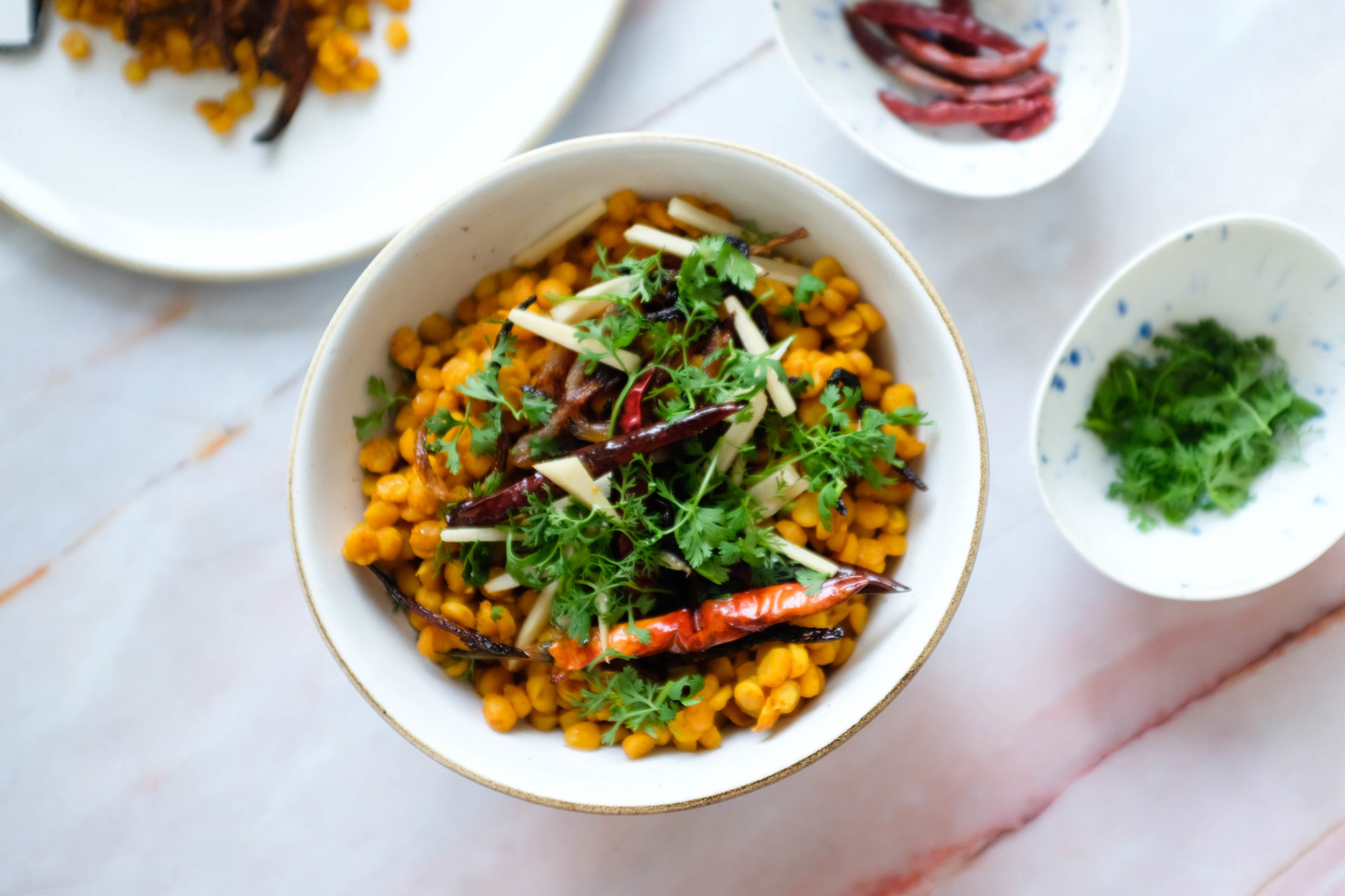
Jump to:
About This Recipe
I revisited the old chana dal recipe I had on the blog after it received a negative review. The past chana dal recipe was less traditional, and given the blog’s focus on “classic” Pakistani recipes, I figured it was only fair to give the readers what they want. This new chana dal recipe is spicier, smokier, and more layered. But while the recipe is new, I still stand by the essay (and the photos, which I thought were quite nice) I wrote to accompany it. It’s my thoughts on authenticity and what makes a recipe ‘Pakistani.’ Many of these thoughts made their way to my book, Pakistan's introduction, which if you haven’t bought already, please consider doing so!
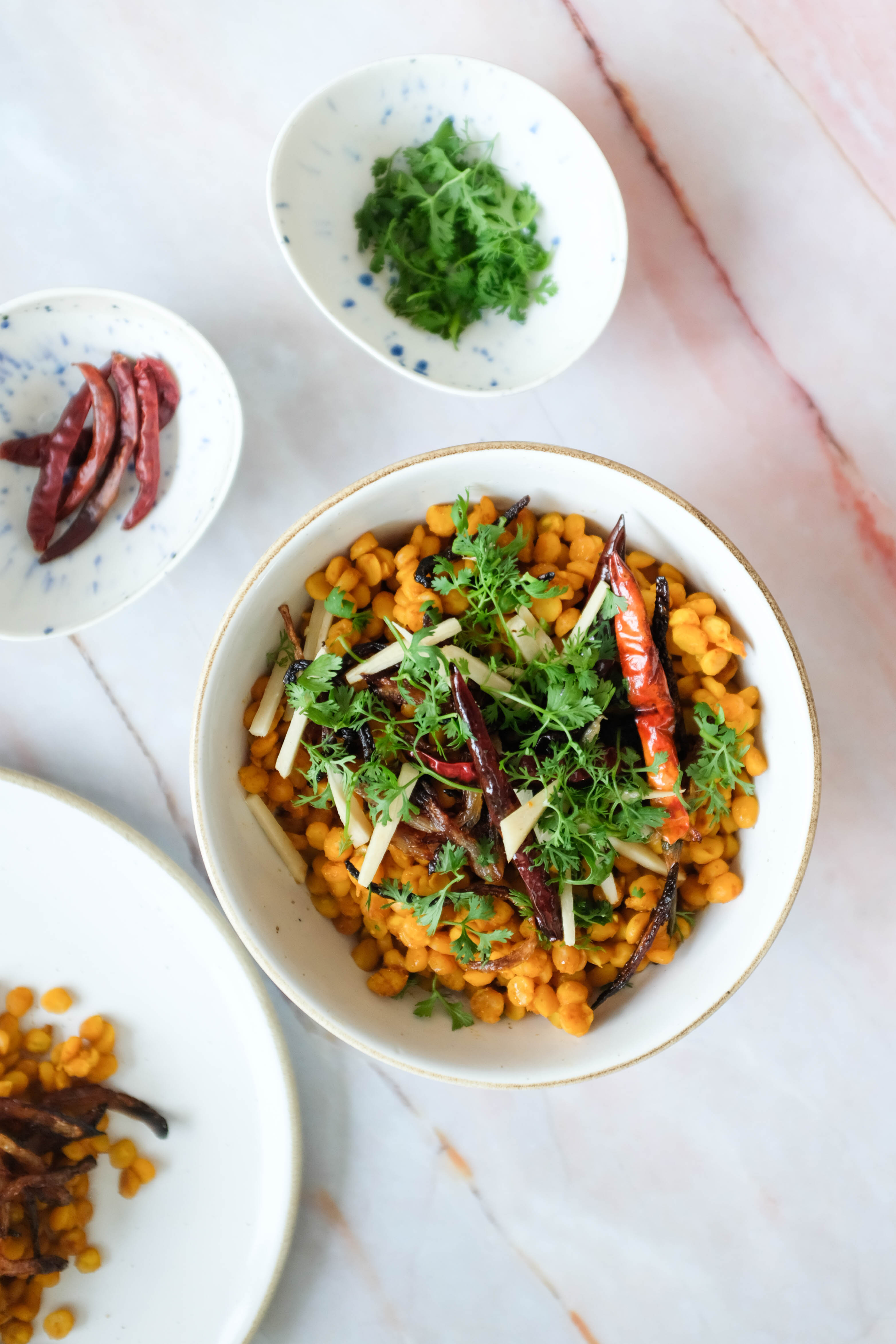
What Makes a Dish "Pakistani"?
Originally published on February 14, 2020
I got back into the kitchen last week after a two-week trip to Pakistan, and picked up Sumayya Usmani’s cookbook, Summers Under the Tamarind Tree again. I made a lovely tapioca pearl kheer for the first time, and revisited her chana dal recipe that I had made several years ago. I have often talked about Usmani’s work, and will make a plug for her books once again, both Summers Under the Tamarind Tree and her more recent, Mountain Berries and Desert Spice. I really appreciate Usmani’s commitment to the entirety of Pakistani cuisine and her effort to share regional recipes. She is also a creative chef, and it’s super fun to observe how she adapts recipes through incorporation of new ingredients and flavors in traditional dishes.
Somebody recently complained that when authors and chefs adapt recipes for a ‘Western audience’, why do they still call the recipes Pakistani? Something about the argument didn’t sit well with me. While I didn’t speak up then, now that I have had time to think through it a little bit more, in order for Pakistani cuisine to evolve and reach its potential globally, we need to start being less rigid about how we view Pakistani food and “traditional”, “authentic” recipes. A narrow, fixed vision of Pakistani food frequently excludes diaspora communities and ignores the impact of migration on food.
Jaya Saxena wrote a great piece on authenticity for Eater recently, where she discusses how our understanding (and by “our”, I’m referring primarily to those in the US) of authenticity has shifted – from us desperately seeking it through hole-in-the-wall restaurants – to shunning it (David Chang, case in point). Right now, at least in the United States, we luckily find ourselves somewhere in the middle where we are recognizing that each person’s definition of authentic is different:
“The goal, then, becomes figuring out what, exactly, someone means when they ask for “authenticity.” Some people are looking for dirt-cheap tacos that fit their limited idea of what Mexican food should be. Others are looking for dishes they tasted decades ago in their birth countries. And then there are those who are searching for food that speaks to every part of themselves, even if that looks closer to “fusion.” The latter is what Soleil Ho spoke of as “assimilation food,” and what Dale Talde calls “diaspora cooking.”
While Saxena’s piece is US-centric and discusses at length how a mainstream US audience engages with the cuisine of a specific culture, within South Asia, I also feel it’s time to broaden our understanding of what is “authentic”, and what is “correct”. As somebody who has been blogging and writing about Pakistani food for 4+ years, and started by crowd-sourcing recipe of traditional dishes from friends and family, there are always a dozen ways to prepare even something as basic as masoor ki dal. Each family and individual has their own take on a recipe, especially those who live overseas. Soleil Ho’s great essay on assimilation food, and similarly, Priya Krishna’s viral cookbook, Indian-ish talk about how their families had to adapt based on what was easy, and what was easily available. They may not be traditional but I would argue that it doesn’t make those dishes less Pakistani/Indian/Vietnamese/etc. – rather, it simply broadens our understanding of what these cuisines are as well as what American/British/Canadian etc. food is.
Although Usmani’s book is not a reference to diaspora cooking, I do love how her personal touches to traditional recipes that are inspired by her new home in Scotland or her culinary training. For instance, stuffed sweet potato parathas or a hibiscus and Himalayan pink salt raita. Given Usmani is Pakistani and has spent years testing out Pakistani recipes, her recipes do not qualify as “Pakistani cuisine” simply because they don’t fall within the narrow definition of what we grew up eating?
Adapting recipes for what is available, what is easier and honestly, what works for you is great. It’s a clever way of keeping traditional dishes relevant, and keeps things in the kitchen interesting. If there are Pakistani and Pakistan-origin food writers, creators and bloggers, that have their own personal and creative spins on traditional Pakistani food, please let me know in the comments!
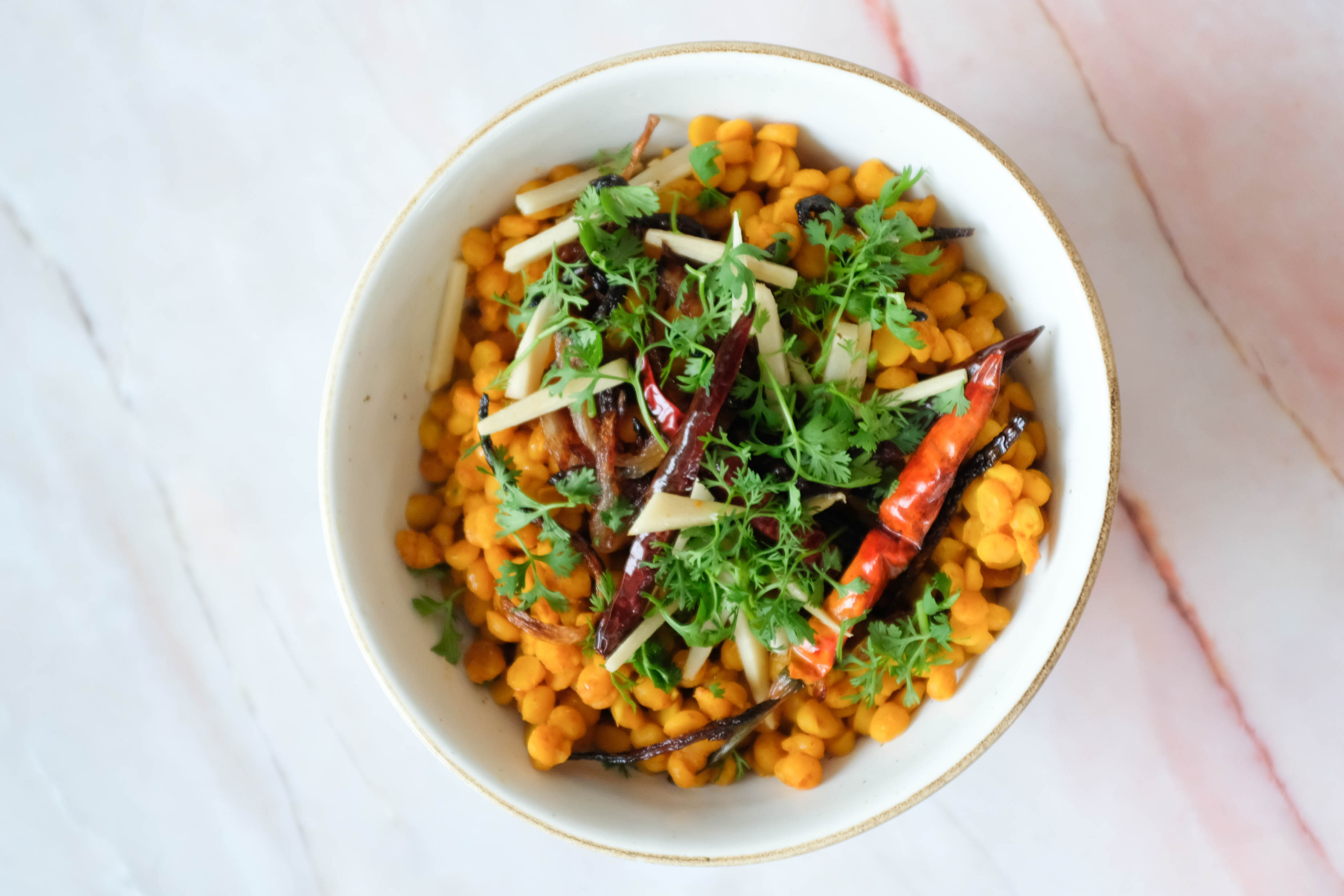
Tips to Make Chana Dal
- Soak the dal in advance: In the case of chana dal, it really helps speed up the cooking process, and give you the texture you want. I like to soak it for 6 to 8 hours for best results.
- Adjust the water amount based on your preferred consistency: Once you boil the chana dal, you will drain the water. After you fold it in with the rest of the tomato and onion base, I suggest simmering it in another 1 cup of water towards the end to give it a thinner consistency. But if you want your dal on the drier side, you can omit this step or reduce the water to half a cup.
- Switch out the tadka: I personally love the simple black pepper tadka – I learned the trick from creator, Fatima Ali of Pots ‘n Curries. But a tadka of dried red chiles also works well here.
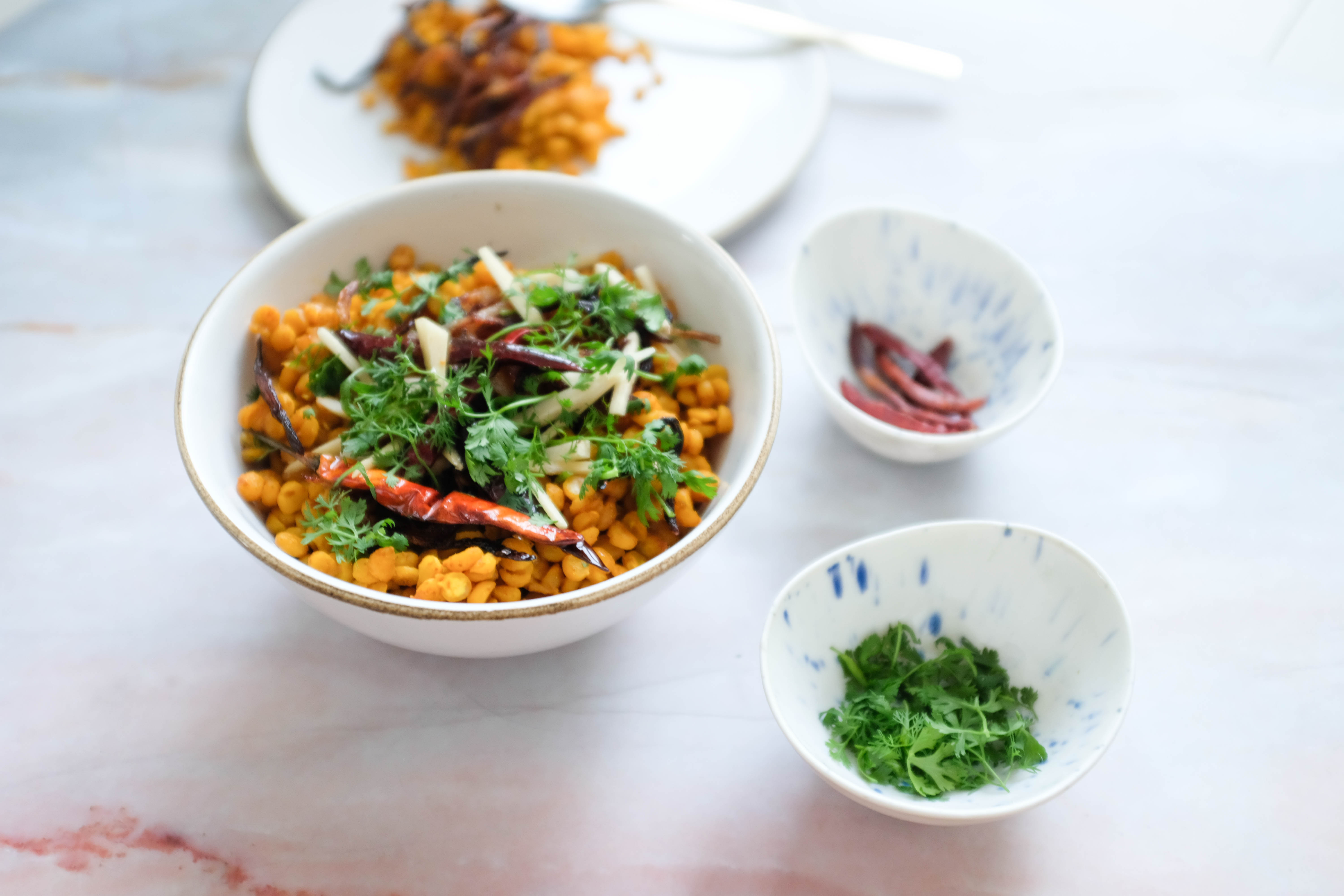
Ingredients
Chana dal (split yellow gram): A type of lentil that can be found in specialty South Asian stores.
Vegetable Oil: Any neutral oil with a high smoke point (such as canola or sunflower) will work.
Yellow Onion: I prefer to use yellow onion here but if you don’t have any on hand, white or red onion will work okay too.
Crushed garlic: You can buy this at the store or just crush it yourself using a food processor or mortar and pestle.
Crushed ginger: You can again, buy this at the store or make it at home. Peel roughly 1-inch piece of fresh ginger, and mince it in a food processor.
Roma or vine tomatoes: In Pakistan, we traditionally use Roma tomatoes but vine tomatoes work here as well.
Coriander powder: Its floral and citrus notes are a nice complement to cumin.
Cumin powder: A pantry essential, it will infuse the dish with earthy and nutty notes.
Garam masala powder: Available in South Asian specialty stores, it infuses the dal with a slightly tangy and smoky flavor. You can also make your own blend. Izzah from Tea for Turmeric has a great recipe here.
Red chili flakes
Kashmiri Red Chili Powder: I always like to use Kashmiri red chili powder because of its beautiful color but if you don’t have any on hand, you can substitute it with cayenne red pepper. Just remember to adjust for heat.
Salt: I use ground Himalayan rock salt but you can use any variety. Just adjust based on taste.
Coarsely ground black pepper
Substitutions
This recipe is similar to the roadside mash ki dal (urad dal) recipe in my book. You can swap out the chana dal for urad if that’s what you have on hand. Both dals work well for this spicy, restaurant style vegetarian main.
What to Serve Chana Dal With
Since I like to serve this dal with naan or roti, I prefer to make it alongside similarly dry mains.
Kali Mirch Chicken Karahi (Black Pepper Chicken)

Chana Dal Recipe
Ingredients
Method
- In a medium to large pot, bring 4 to 5 cups of water to boil. Add 1 tablespoon of salt and fold in the dal. Lower heat to medium, and cook the dal until tender but firm, about 35 to 40 minutes. Once the dal is ready, drain the water and set it aside.
- Heat ⅓ cup oil in a heavy-bottomed pot until it begins to shimmer. Add diced yellow onion and fry on medium heat until it begins to soften and brown at the edges, 5 to 7 minutes.
- Lower heat to medium-low. Add crushed garlic and ginger, and stir until it stops smelling raw, about 30 seconds to 1 minute.
- Increase heat to medium-high and add chopped tomatoes, coriander, cumin, garam masala powder, chile flakes, red chili powder, and remaining salt. Stir until well-mixed and bring heat to low. Cover and let the tomatoes soften about 10 minutes, stirring occasionally to make sure they don’t stick to the bottom of the pan.
- Once they have softened, fold in the boiled dal. Stir until well-coated in the tomato and onion base. Add 1 cup of water, cover and bring to boil. Lower to simmer and let the dal cook for another 5 to 8 minutes.
- Heat 2 tablespoon of oil in a small frying pan. Once it begins to shimmer, add the coarsely ground pepper and swirl for a few seconds until fragrant. Remove from heat and pour over dal.

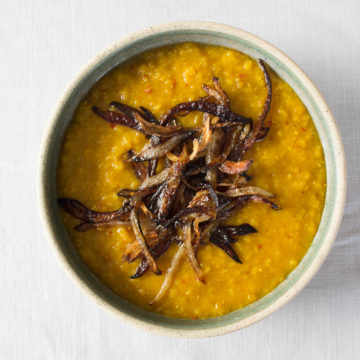
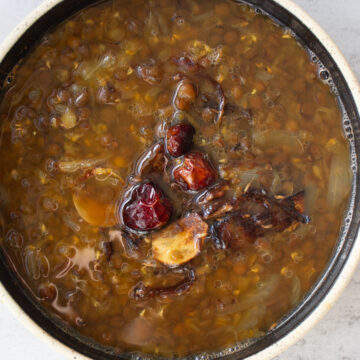
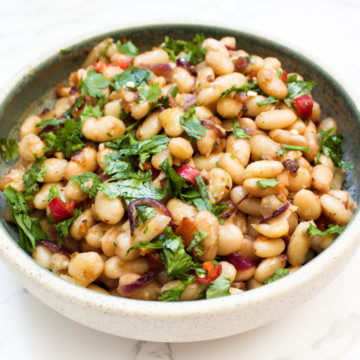
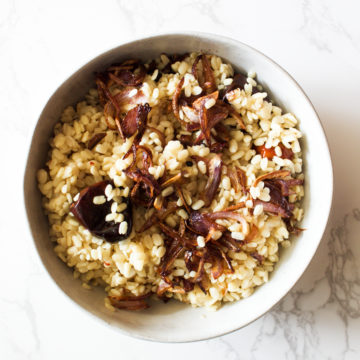
Fatima Cooks says
What a wonderful read. I agree with you 100% - adapting a recipe to suit modern developments, what is available, family tastes etc should not be looked down upon nor should it make a food any less 'traditional'. While there is a unique place for the traditional, authentic and 'untouched by the modern world' sort of food, there is also a place for those adapted to suit us more - and it's right to say the latter is what will help us keep the former alive!
pakistaneats says
Thanks so much Fatima! Absolutely agree with you that there is a unique place for traditional, authentic recipes as well. We should stop ascribing judgment to either.
Chili to Choc says
I have never tried tarmarind paste in channa daal. An interesting addition!
Gia Prasad says
This was fantastic! Easy to make and so unique! Adding this as a regular to our rotation after today! Thank you for sharing! Looking forward to trying more Pakistani dishes!
Dido says
Hi Maryam: Thank you much for your recipe. In the list of ingredients, the crushed garlic has been repeated. Looks to me the repetition refers to crushed ginger.. ~ Dido.
pakistaneats says
thanks so much for catching that! I'll correct it now.
David says
With so much displacement of Pakistani people into the wider world in the last decade, when you talk about authenticity, I think you have to anticipate a flood of fusions and bastardizations of traditional recipes around the sorts of improvisations done by homesick working men abroad using local ingredients and convenience store items and the like.